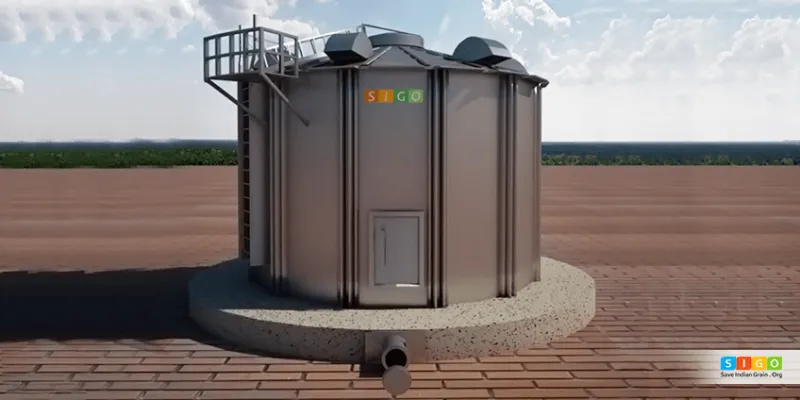Lucknow-based Save India Grain works with cluster maps to reduce post-harvest grain loss
Do you know that India is among the top three grain producers in the world with an annual output of 265 million metric tons of good grain? Although India feeds a sixth of humanity each year, 17 per cent of the country's population remains malnourished.
The problem of malnutrition and post-harvest loss alarmed Anurag Awasthi, a social entrepreneur and accountant from Lucknow. Anurag, who had previously worked with several not-for-profit organisations in Washington, D.C., decided to work with the Indian agricultural sector – a sector that contributes to 20 per cent of India's GDP and employs 50 per cent of the population.

With research, he found that storage was a major gap in the food supply chain and that several small and marginal farmers were forced to sell their harvest due to lack of storage capacity. Other factors that fuelled the distress sale of their harvest were the impending monsoon and an urgency to clear debts.
Using data to fix the problem
This led him to set up Save Indian Grain. Org (SIGO) dedicated to the design, development and delivery of modern grain storage solutions, subsistence market places and agri-supply chain directories, and cluster maps for small and marginal farmers in rural India.
Further, spot market prices of commodities during harvest season were much lower than the minimum support prices (MSP) offered by the government and therefore, a sale in open markets fetched a lower return during bumper seasons.
"We hope to sensitise people to the global endemic of post-harvest losses and in the process, stem post-harvest losses in our agri-market yards and warehouses in India," says Anurag.
Analysing the spreadsheets and tables with data on losses requires domain and subject expertise, which often deters laymen from working with the data to understand the information made available. Agriculture statistics requires interest and expertise by an agro-economist or someone who is a stakeholder in the agriculture sector.
SIGO uses Google Maps and APIs to visually represent Big Data on a single page. Cluster maps are built based on the concentration of producers, agri-businesses, and institutions engaged in the agricultural or agro-industrial sub-sector. It helps them interconnect and build value networks, address common challenges and pursue co-aligned opportunities
"This project is being advised by a group of retired IITians, who seek to use their knowledge and their technical and professional experience for the social development of the nation," says Anurag.
On-field research and its benefits
After developing a hopper-bottom silo, a high-tensile galvanized steel storage bin that can be used to hold wet grain, store seeds for the next harvest, or a bin for tempering dried grains, SIGO decided to go to market with this product. The product was aimed at solving the grain storage problem being faced by the farmers.
While they were developing a proof-of-concept model, Anurag had the opportunity to interact with professionals within the agriculture and food industry, who advised him to spend time with farmers on the ground to get first-hand knowledge of the problems they faced.
"I took their advice and visited mandis near Lucknow and interacted with farmers to understand their post-harvest experience," says Anurag. After analysing the information gleaned from interacting with farmers and grain merchants at mandis, Anurag realised that analysing the Base-of-the-Pyramid (BoP) market was key to designing and marketing solutions.
With his on-the-field findings, Anurag went back to the drawing board and started work on the design and development of a flat-bottom farm bin. He says that technology and business models must be designed and developed to serve and benefit the masses, instead of a select few. "In other words, develop products and services where focus is on access rather than ownership," adds Anurag.
Figuring the regulations out
Setting up SIGO involved a fair understanding of the symptoms resulting in post-harvest losses and identifying the problem at hand, a fair understanding of State and Central policies and regulations, various drivers and stakeholders participating at each step of the supply chain.
Anurag says, “If you were to ask a management accountant about design cost principles, you would be told that 70 per cent of the product cost is locked up in the design stage and the remaining 30 per cent in the manufacturing stage. We spent the first two years figuring out the symptoms, identifying the problems, and understanding our core stakeholders – the farmer and the end-consumer.”
Once they identified and understood the problems that their real stakeholders faced, they were able to design and tailor their solutions. The primary focus has been to serve the need of their core stakeholders with a neat solution at an optimal cost.
SIGO has just commenced operations and is in the process of reaching out to various stakeholders within the agriculture and food processing sector. They have received expression of interest from the corporate sector, global NGOs, various state governments and the Government of India.
Also read: After making wood, Chloroearth aims to create cement and steel to build smart villages
Market space
Currently bootstrapped, SIGO is looking for investment. Globally, four billion people make less than USD 3,000 a year or roughly USD 8 a day. 60 per cent of this Base-of-the-Pyramid (BoP) population lives in India and China, and 70 per cent of BoP households’ budgets are spent on food.
By 2060, the global population is expected to reach nine billion, and we will have to increase our food production by nearly 50 per cent from our current production levels to feed all. With shrinking land resources, unpredictable rainfall patterns and impending climate change scenarios, there is a need to stem post-harvest losses without any further delay.
SIGO wants to get this message to all Indians and sensitise them to the impending food security challenge that is round the corner.







